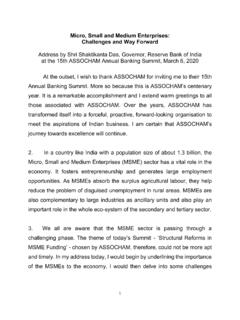Transcription of User guide - European Commission | Choose your language
1 Internal Market, Industry, Entrepreneurship and SMEsUser guideto the SME Defi nitionRef. Ares(2016)956541 - 24/02/2016 DISCLAIMERThis SME User guide serves as general guidelines for entrepreneurs and other stakeholders when applying the SME Definition. It does not have any legal force and does not bind the Commission in any way. Commission Recommendation 2003/361/EC, as published in the Official Journal of the European Union L 124, p. 36 of 20 May 2003, is the sole authentic basis for determining the conditions regarding qualification as an guide contains: details and explanations of the SME Definition which took effect on 1 January 2005; a model declaration form that individual companies may complete when applying to SME support schemes in order to establish their SME Direct is a service to help you find answers to your questions about the European UnionFreephone number (*):00 800 6 7 8 9 10 11(*) The information given is free, as are most calls (though some operators, phone boxes or hotels may charge you).
2 More information on the European Union is available on the internet ( ). Cover picure: Gettyimages Picures: ThinkstockLuxembourg: Publications Office of the European Union, 2015 Print ISBN 978-92-79-45322-9 ET-01-15-040-EN-C PDF ISBN 978-92-79-45301-4 ET-01-15-040-EN-N European Union, 2015 Reproduction is authorised provided the source is ..3 Why a European SME Definition? ..4 The objectives of this guide ..6 Applying the SME Definition ..7An overview of the SME identification process ..8 Step 1: Am I an enterprise? ..9 Step 2: Which criteria need to be checked and what are the thresholds (Article 2)? .. 10 Step 3: What do these criteria cover? ..12 Criterion 1: Staff headcount (Article 5) ..12 Criteria 2 and 3: Annual turnover and balance sheet total (Article 4) .. 13 Step 4: How do I calculate these data? ..15Am I an autonomous enterprise (Article )? ..16Am I a partner enterprise (Article )? ..18Am I a linked enterprise (Article )?
3 21 Conclusion ..24 Examples .. 25 Background to the current SME Definition and user guide .. 31 Glossary .. 33 Annexes ..37 Text of the Recommendation .. 38 Model declaration form ..44 SMEs: the engine of the European economySMEs are the engine of the European economy. They drive job creation and economic growth and ensure social stability. In 2013, over 21 million SMEs provided million jobs throughout the EU. Nine out of every 10 enterprises is an SME, and SMEs generate two out of every three jobs. SMEs also stimulate an entrepreneurial spirit and innovation throughout the EU and are thus crucial for fostering competitiveness and their importance to Europe s economy, SMEs are a major focus of EU policy. The Europe-an Commission aims to promote entrepreneur-ship and improve the business environment for SMEs, thereby allowing them to realise their full potential in today s global economy.
4 Identifying genuine SMEsSMEs come in many different shapes and sizes; however, in today s complex business environ-ment they may have close financial, operational or governance relationships with other enterpris-es. These relationships often make it difficult to precisely draw the line between an SME and a larger enterprise. The SME Definition is a prac-tical tool designed to help SMEs identify them-selves so that they can receive the full support of the EU and its Member new boost for jobs, growth and investment is the first priority of the President of the European Commission Jobs, growth and investment will only return to Europe if we create the right regulatory environment and promote a climate of entrepreneurship and job creation. We must not stifle innovation and competitiveness with too prescriptive and too detailed regulations, particu-larly when it comes to small and medium-sized enterprises (SMEs).
5 SMEs are the backbone of our economy, creating more than 85 % of new jobs in Europe and we have to free them from burdensome regulation. Jean-Claude Juncker, President of the European Commission The category of micro, small and medium-sized enterprises (SMEs) is made up of enterprises which employ fewer than 250 persons and which have an annual turnover not exceeding EUR 50 million, and/or an annual balance sheet total not exceeding EUR 43 million. Extract of Article 2 of the annex to Recommendation 2003/361/EC Nine out of every 10 enterprises is an SME, and SMEs generate two out of every three jobs. 3 USER guide TO THE SME DEFINITIONWhat EU support exists for SMEs?For an overview of the main funding opportunities available to European SMEs, please visit: !RT38 NyWHY A European SME DEFINITION? One of the main objectives of the SME Recom-mendation is to ensure that support measures are granted only to those enterprises that gen-uinely need them.
6 The SME Definition, therefore, applies to all policies, programmes and meas-ures that the European Commission develops and operates for SMEs. It also applies to the kind of State Aid where there are no ad hoc guidelines applicable (1). Deciding whether or not a compa-ny is an SME is not as simple as one might think, though.(1) Not all State Aid rules adhere to the strict interpretation of the SME Definition. Some are directly based on it, others only apply the SME Definition in part, and there are specific guidelines that apply in certain cases. It is therefore always necessary to carefully check the respective legal basis in case an enterprise receives state support. If an enterprise has access to significant additional resources it might not be eligible for SME status. Size isn t everythingIn determining whether or not an enterprise is an SME, the en-terprise s size (employees, turnover and balance sheet total) is not the only factor that should be taken into ac-count.
7 In fact, an enterprise can be very small in these terms, but if it has access to significant additional resources ( because it is owned by, linked to or partnered with a larger enterprise) it might not be eligible for SME status. For enterprises with a more complex structure, a case-by-case analysis may therefore be required to ensure that only those enterprises that fall within the spirit of the SME Recommen-dation are considered versus non-SME: the main criteriaSize Employees Turnover Balance sheet totalandResources Ownership Partnerships Linkages4 Helping to avoid competitive distortionIn a single market with no internal frontiers and in an increasingly globalised business environment, it is essential that measures in support of SMEs are based on a common definition. Lack of a common definition could lead to the uneven application of policies and thus distort competition across Member States.
8 An enterprise in one Member State, for example, might be eligible for aid, while an enterprise in another Member State of exactly the same size and structure might not be eligible. A common definition helps to improve the consistency and effectiveness of SME policy across the EU. Moreover, it is all the more necessary given the extensive interactions between national and EU measures designed to help SMEs in areas such as regional development and research unique set of issuesIt is also important to identify which enterprises truly are SMEs because SMEs require assistance that other enterprises do not. Compared with other enterprises, SMEs are confronted with a unique set of issues. Market failures: real SMEs often face market failures that make the environment in which they operate and compete with other players more challenging. Market failures may occur in areas such as finance (especially venture capital), research, innovation or environmen-tal regulations; SMEs may be unable to ac-cess finance or invest in research and innova-tion or they may lack the resources to comply with environmental regulations.
9 Structural barriers: SMEs often must also overcome structural barriers such as a lack of management and technical skills, rigidities in labour markets and a limited knowledge of opportunities for international expansion. Given the relative scarcity of funds, it is important to reserve the advantages of SME support pro-grammes for genuine SMEs. With this in mind, the Definition includes several anti-circum-vention measures. The simplified ap-proach of the present guide should not be used to justify the creation of artificial corporate structures that aim to bypass the Member States, use of the Definition is vol-untary, but the Commission invites them, togeth-er with the European Investment Bank (EIB) and the European Investment Fund (EIF), to apply it as widely as possible. SMEs require assistance that other enterprises do not. 5 USER guide TO THE SME DEFINITIONTHE OBJECTIVES OF THIS guide Registering as an SME: multiple entry pointsThere is no single point of entry to register an enterprise as an SME.
10 Depending on the funding programme and the managing authority ( European , national, regional) to which one applies, there will be separate registration procedures. Efforts are being made to enable as many online registrations as possible. The Your Europe website provides information on funding programmes and will point you to the relevant registration desks when applicable and available: example is the Beneficiary Register on the Horizon 2020 Participant Portal information contained in this guide is primar-ily designed for two audiences: entrepreneurs : entrepreneurs running mi-cro, small or medium-sized enterprises, who are interested in applying for grants or loans aimed at SMEs these entrepreneurs may also want to know if they satisfy the criteria to benefit from specific legislative provisions or reduced fees for SMEs; government officials: European , national, regional and local officials who draw up and run the various schemes , process the applica-tions and ensure that companies satisfy the eligibility criteria for support.














